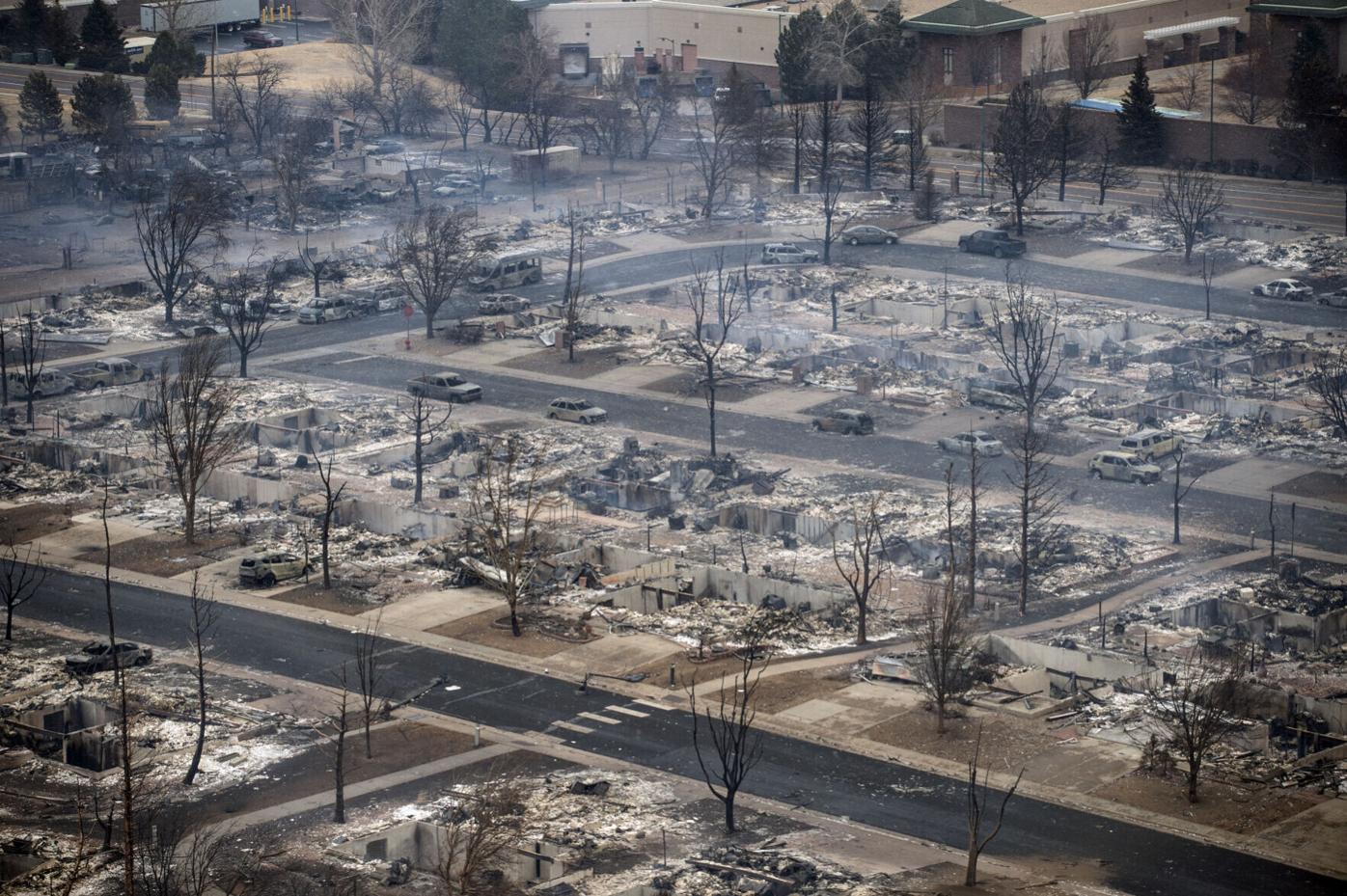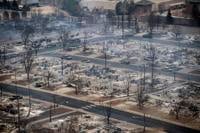Palisades wildfire winds, speed, ferocity similar to Colorado’s Marshall fire
Five separate wildfires raged throughout Southern California on Wednesday, killing five, leaving behind the wake of destruction and the skeletons of homes and trees.
Meanwhile, in Colorado, some communities in Boulder County recently mourned the third anniversary of the Marshall fire — a wildfire that tore through unincorporated Boulder County, Louisville and Superior and left more than 1,000 families homeless and businesses burned on Dec. 30, 2021.

Ariel photos of homes that were destroyed in the Marshall fire on Dec. 31, 2021. More than 500 homes were destroyed and that number could climb to nearly a 1,000.
John Leyba, Air Cam Helicopter Services

Ariel photos of homes that were destroyed in the Marshall fire on Dec. 31, 2021. More than 500 homes were destroyed and that number could climb to nearly a 1,000.
The two fires, though they occurred in different types of terrain, are eerily similar. Notably, the high winds are the significant factor in the whipping flames tearing through the Los Angeles region, just as the fast-moving winds fanned the fire in Colorado.
“It’s very reminiscent of the Marshall fire,” said Rick Tillery, a representative with Mountain View Fire Rescue, one of the many departments that battled the 2021 blaze.
“It’s very similar in the way this fire is transpiring with the high-winds and very fast moving flame front and fire lines,” he said.
To this day, former residents of Boulder County are struggling to rebuild homes and recover from the more than 6,000-acre blaze.
Palisades fire update
The Palisades fire, which started on Tuesday morning, has forced the evacuation of at least 30,000 residents in the affluent neighborhood of Pacific Palisades. And more than 130,000 people are under evacuation orders in the metropolitan area.
The fire was first reported at 10:30 a.m. local time Tuesday and has grown to 11,082 acres with zero containment, according to the California Department of Forestry and Fire Protection.
A second wildfire, the Eaton fire, broke out on Tuesday night in the hills above Altadena, a community in northern Los Angeles County, also prompting evacuation orders. At least five people are dead because of the blaze, which burned at least 10,600 acres as of Wednesday morning, according to officials.
The Hurst fire, a third blaze, erupted in the Sylmar neighborhood of Los Angeles late Tuesday night and quickly consumed hundreds of acres, also forcing some evacuations, the state fire department said.
The Woodley fire started early on Wednesday morning.
More than 1,000 structures were destroyed and numerous people were hurt in the fires, including first responders, said Los Angeles County Fire Chief Anthony Marrone.
With thousands of firefighters already attacking the flames, the Los Angeles Fire Department put out a plea for off-duty and out-of-state firefighters to help. The strong winds had temporarily stopped aircraft from dumping water from above until they were able to resume flights.
A fifth wildfire called the Sunset fire was burning near the Hollywood Bowl and other iconic landmarks in the Hollywood Hills on Wednesday night.
Micki Trost, the strategic communications director for the Colorado Division of Homeland Security and Emergency Management, Colorado, as well as its western neighbors, received an Emergency Management Assistance Compact (EMAC) request for 40 strike teams from each state, equaling 200 fire engines to help the blaze.
EMAC is an interstate mutual aid agreement that allows states to share resources during disasters without a set price, giving states the freedom to set the prices of aid.
As of Wednesday afternoon, Colorado had not yet sent any aid via the EMAC request but there’s a chance that would happen — and fire officials here are preparing.
Interagency Resource Ordering Capability (IROC) is the traditional way of asking other states for resources for all hazard incidents with set prices.
Through IROC, the Colorado Division of Fire Prevention and Control has sent a multi-mission aircraft to California, according to Trost. The aircraft does not fight fires, but flies higher above the blaze and provides information back to firefighters.
“We’ve not been contacted for resources but we are preparing,” said Tillery of Mountain View Fire Rescue. “We had a lot of people come in to help our agency during the Marshall fires… We want to make sure that we’re able to go back out and help people while we can.”
‘It’s fierce, it’s brutal’
The Marshall fire, which killed two people and destroyed 1,084 homes in around eight hours on Dec. 30, 2021, started during a dry day when winds were whipping near 100 mph.
This Wednesday morning, the National Weather Service received reports of winds up to 80 mph near the California fires. They could top 100 mph in mountains and foothills and include areas that haven’t seen substantial rain in months.
Strong winds, dry climates and warmer temperatures have caused the fires to spread quickly — conditions that gave the Marshall fire speed and ferocity.
“As far as the destruction, they’re comparable because they both hit fairly populated areas very quickly,” wildfire litigator Ben Petiprin said.
While Petiprin lives in California, he led the lawsuit against Xcel Energy after the Marshall fire, alleging the power company is responsible for victims’ financial losses, emotional distress and punitive damages.
Tillery added that the 20 mph wind difference makes no significant difference to the spreading of the fire; both, he said, are strong winds.
“When you’re on the ground, 85 to 100 isn’t that much different,” he said. “It’s fierce, it’s brutal. You do what you can to save what you can. You just try to save lives.”
Terrain and potential causes
The difference between the fires, at least so far, is the terrain in which firefighters had to navigate.
The Palisades fire sits in a mountainous region near the coast. The Marshall fire was in a fairly flat suburban area, according to Tillery.
“The difference – it wasn’t in the mountains here. It came across the mesa and into the towns. We didn’t have to fight it in the mountains, but it was tough because we were battling 100 mph winds,” he said.
The rough terrain mixed with the winds makes the Palisades fire potentially even tougher to contain, he said.
After 17 months of investigation, the Boulder County Sheriff’s Office announced the Marshall fire was actually two separate fires started by two separate causes within 2,000 feet and an hour apart.
The first was human-caused by a fire at property owned by Twelve Tribes that was left to smolder six days earlier. Investigators said the fire had been covered in dirt, but on Dec. 30, 2021, the high-wind event uncovered and reignited the smoldering fire.
The second was an unmoored Xcel Energy power line near the Marshall Mesa Trailhead that sparked at around noon.
Xcel Energy denied its lines caused the fire.
According to Petiprin, there are three-or-four fire points that started the Palisades blaze.
In Colorado, the Marshall fire civil suit against Xcel blamed a powerline as starting the second point of the fire. Meanwhile, Southern California Edison reported to have turned off the power lines to the nearby area in the Palisades fire.
Petiprin, the lawyer, said that, legally, it’s too early to compare the fires.
“All of these people that lost their homes are going to rely on their insurance carriers to make them whole. If there’s a responsible party, like utility, they will be the ones that contribute to making people whole. They’ll get benefit of insurance, plus whatever they can prove in court,” he said.
He said there’s going to be a lot of time and research to figure out causes. He doesn’t think about potential them until the fires are extinguished, he said.
Firefighters were battling the blaze on Wednesday evening.
“We are prioritizing life over everything else,” Los Angeles County Sheriff Robert Luna said.
The Associated Press and Denver Gazette reporter Carol McKinley contributed to this report.





